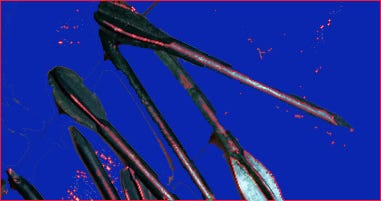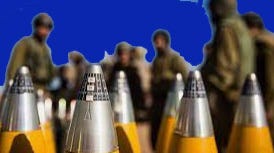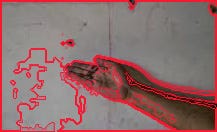Operation Cast Lead Part 6 Flechettes
One of the nastier weapons employed by the Israelis were flechettes. According to Amnesty International, “flechettes are 3.5cm-long steel darts, sharply pointed at the front, with four fins at the rear. Between 5,000 and 8,000 of these darts are packed into shells, which are generally fired from tanks. The shells explode in the air and scatter the flechettes in a conical pattern over an area about 300m by 100m. Flechette rounds are designed to be used against massed infantry attacks or squads of troops in the open and obviously pose a very high risk to civilians when fired in densely populated civilian residential areas.”
One IDF soldier reported: “Once I was allowed to fire and I realized it was really inside a neighborhood. Houses. Then I finally understood. Most of the time we were firing at launcher crews in open spaces, but it didn’t take much to aim at schools, hospitals and such. So, I see I’m firing literally into a built-up area. I don’t know to what degree it was still inhabited because the army made considerable attempts to get people to leave, but I understand that ... It feels terrible that we fired there.”
Amnesty International stated: “...on the 5th of January 2009, Israeli forces fired several flechette shells into the main road near the Abd al-Dayem family home in ‘Izbet Beit Hanoun, to the south-west of Beit Hanoun. Six civilians — two children, a woman and three men — were killed and several others were injured. Twelve-year-old Arafat Abd al-Dayem was killed instantly and 16-year-old Islam Jaber Abd al-Dayem was struck in the neck by flechettes. He was taken to hospital but died three days later. Mizar, his brother, was injured in the same attack and still has a flechette lodged in his back. Nearby, 21-year-old Wafa’ Abu Jarad, who was pregnant, her two-year-old son, her husband, her father and her brother-in-law were all injured by flechettes in the courtyard of their home. Wafa’ died of her injuries two days later. Her husband, Mohammed, told Amnesty International: “We had just had breakfast, then we had tea. We walked a bit in the garden, to the corner of the house, just a few meters from the front door. Then we heard shelling, followed by screaming. We turned back, towards the door. As we got to the door, we were hit. Wafa’ fell on the steps. There was blood everywhere.”
Amnesty International reported: “On the 5th of January at about 1 p.m. Ibrahim Jouha, 14, was shot in the chest as he was carrying a white flag and walking with his parents and siblings and neighbors near his house in the al-Zaytoun district, in the south- east of Gaza City. His mother, Mudallala Jouha, told Amnesty International: “On the night between Saturday the 3rd and Sunday the 4th of January the army was shelling all around us. We were in the house — me, my husband Mou‘in Jouha (an agricultural engineer who has worked for the Agriculture Ministry since the establishment of the PA 15 years ago), his second wife; our 10 children and my husband‘s mother. We were scared and lay on the floor in the inside rooms for protection. At dawn the soldiers came to the house (on the Salahaddin Road). We all kept our hands above our heads. The soldiers smashed walls and dug up the floors to get sand to fill the bags (to protect their snipers shooting from the holes in the walls). The soldiers told us to leave the house and to walk south, to Rafah. But this was impossible; it was too dangerous to walk south. We went to a neighbor (Abu Zouhr family) and there we found other neighbors (the Sawafiri and Mughrabi families) also sheltering. We all stayed there till the following morning (the 5th of January) and then after much shelling soldiers came and told us to leave but again told us to go to Rafah and did not let us walk north to Gaza City. The soldiers fired in our direction so we sheltered in the garage next door. We were more than 50 people, most of us children. Then we decided to walk north to Gaza City, past our house, which had been taken over by the soldiers. We put my husband’s mother in a small cart because she could not walk and we could not carry her. My husband pushed the cart and my son, Ibrahim, aged 14, walked next to him with a white flag. We walked with our hands up. The soldiers shot at us from the Abu Zouhr family’s house and hit my son Ibrahim in the chest. We carried him back to the garage and called the Red Crescent ambulance but the army did not allow ambulances to come there. We stayed all day and all night. Ibrahim was in pain and I held him lying in my lap. I tried to keep him warm and to stop his bleeding but he died at about 2 a.m. We were finally able to leave two days later (on the 8th of January), when the Red Cross was allowed to come to the area to evacuate people.”
An IDF soldier stated: “You see a house, a window, shoot at the window. You don’t see a terrorist there? Fire at the window. It was real urban warfare. This is the difference between urban warfare and a limited confrontation. In urban warfare, anyone is your enemy. No innocents.”
Amnesty reported: “Amal Zaki ‘Eilewa, a 40-year-old mother of eight, was killed with four of her children in their home in the Shaja‘iya al-Jdeida neighborhood of Gaza City in the afternoon of the 5th of January 2009. Amal was in the kitchen, on the first floor of the house, and her husband and children and nieces were in the kitchen and in the adjacent rooms. It was 4.05 p.m. when a tank shell hit the house. It went through the north- east-facing bedroom window, smashed through the wall into the kitchen and exploded there, killing Amal, her 10-year-old daughter Lana, and three of her sons, Mu’tasem, Mu’min and Isma’il, aged 14, 12 and seven respectively. Her husband Heidar and their son Muntaser, 16, daughter Ghadir, 15, and niece Lama, 12, were injured.”
One IDF soldier spoke of “the hatred, and the joy of killing...” and another stated: “One guy said he just couldn’t finish this operation without killing someone. So, he killed someone...”







